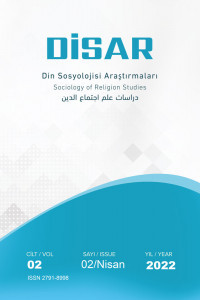Mühtediler, Beynamazlar ve Hariciler: Amerika Birleşik Devletleri’nde Müslüman Olmak ve İslami Yaşam Deneyimleri- Clifton Camisi Örneği
Ohio eyaletinin önemli şehirlerinden Cincinnati küçük bir Müslüman topluma ev sahipliği yapmaktadır ve bu Müslüman cemaatin Clifton Cami adında kültürel merkez olarak da işlevsel olan bir camileri vardır. Bu çalışma Cincinnati’deki Müslümanlar üzerine camiyi merkez alan bir etnografik araştırmanın ürü-nüdür. Amerika Birleşik Devletleri’ nde, Müslümanlar özellikle de 11 Eylül (2001) saldırılarından sonra yükselen bir tür ırkçılık ile karşı karşıyalar. Kimi uzmanların İslamofobi olarak niteledikleri bu yeni ırkçılık yeni muhafazakârlık dalgalarıyla birlikte yükseliştedir. Bu araştırmanın amacı bu ayrımcılık, baskı ve İslamofobi zamanlarında Müslümanların Amerikan toplumunda karşılaştıkları sıkıntılarını ortaya koymaktır. Araştırmanın birbiri ile ilgili başlıca soruları; Müslümanlar kendilerine karşı bir ‘fobi’ algılıyorlar mı? Göçmenler özelinde, geldikleri bu yeni ülkede topluma eklemlenmek, toplumla kaynaşmak için bir önerileri ve çabaları var mı? Ve ABD’de kendi kişisel tecrübeleri nedir? Ancak bu çalışma bu sorulara nihai bir cevap bulma iddiasında değildir. Sorular farazi olduğu kadar, cevaplar da farazi ve değişkendir.
Anahtar Kelimeler:
İslam, İslamofobi, Clifton Camisi, Cincinnati, ABD, ırkçılık, etnografi.
___
- Ahmet Haşim. Frankfurt Seyahatnamesi. İstanbul: YKY,2013 [1933].
- Ajrouch, Kristine J. “Global contexts and the veil: Muslim integration in the United States and France”. Sociology of Religion 68(3) (2007): 321-325.
- Al Wazni, Anderson B. “Muslim women in America and hijab: A study of empowerment, femi-nist identity, and body image”. Social Work 60(4) (2015): 325-333.
- Bauman, Zygmunt. Sosyolojik Düşünmek, Çev. Abdullah Yılmaz. İstanbul: Ayrıntı yayınları, 2009.
- Becker, Howard S. Outsiders: Studies in the Sociology of Deviance. New York: The Free Press, 2008[1963].
- Bonilla-Silva, Eduardo. Racism without Racists: Color-Blind Racism and the Persistence of Racial Ine-quality in the United States. Lanham: Rowan and Littlefield, 2013.
- Bowen, Patrick D. A History of Conversion to Islam in the United States, Volume 2: The African Amer-ican Islamic Renaissance, 1920-1975. Boston: Brill, 2017.
- Clough, Patricia T. “Autotelecommunication and autoethnography: A reading of Carolyn Ellis’s final negotiations”. Sociological Quarterly 38 (1997): 95–110.
- Curtis IV, Edward E. Muslims in America: A short history. New York: Oxford University Press, 2009.
- Daniels, Roger. Coming to America: A History of Immigration and Ethnicity in American Life. New York: Harper Collins, 1990.
- Eisgruber, Christopher L. - Sager, Lawrence G. Religious freedom and the constitution. Boston: Har-vard University Press, 2009.
- Ernst, Carl (Ed.). Islamophobia in America: The anatomy of intolerance. New York: Springer, 2013.
- Fox19 News, “Explosion Hits Clifton Mosque”, 21 Aralık 2005. Retrieved (https://www.fox19.com/story/4272420/explosion-hits-clifton-mosque/) (Erişim: 18 Mart 2021).
- Ghaffari, Azadeh - Çiftçi, Ayşe. “Religiosity and self-esteem of Muslim immigrants to the Uni-ted States: The moderating role of perceived discrimination”. International Journal for the Psychology of Religion 20(1) (2010): 14-25.
- Ghumman, Sonia - Ryan, Ann Marie. “Not welcome here: Discrimination towards women who wear the Muslim headscarf”. Human Relations 66(5) (2013): 671-698.
- Grandin, Greg. The Empire of Necessity: Slavery, Freedom, and Deception in the New World. New York: Metropolitan Books, 2014.
- Goffman, Erving. The Presentation of Self in Every Day Life. Edinburg: University of Edinburg Press, 1956.
- Gomez, Michael A. Black crescent: the experience and legacy of African Muslims in the Americas. New York: Cambridge University Press, 2005.
- Haddad, Yvonne Y. Not quite American?: The shaping of Arab and Muslim identity in the United Sta-tes. Waco, TX: Baylor University Press, 2004.
- Hurd, Elizabeth S. Beyond Religious Freedom. Princeton: Princeton University Press, 2015.
- Jalalzai, Farida. “The politics of Muslims in America”. Politics and Religion 2(2) (2009): 163-199.
- Kaplan, Jeffrey. “Islamophobia in America?: September 11 and Islamophobic Hate Crime”. Terrorism and Political Violence 18:1 (2006): 1-33.
- Livengood, Jennifer S. - Stodolska, Monika. “The effects of discrimination and constraints ne-gotiation on leisure behavior of American Muslims in the post-September 11 America”. Journal of Leisure Research 36(2) (2004): 183-208.
- Love, Erik. Islamophobia and racism in America. New York: New York University Press, 2017.
- Nowrasteh, Alex, “Muslim Immigration and Integration in the United States and Western Eu-rope”. CATO Institute. (2016) Retrieved ( https://www.cato.org/blog/muslim-immigration-integration-united-states-western-europe). (Erişim: 29 Ocak 2021).
- Omi, Michael - Winant, Howard. Racial Formation in the United States: From the 1960s to the 1990s. New York: Routledge, 2014.
- Rauf, Feisal A. “The relationship between the Muslim world and the United States and the root of Islamophobia in America”. Journal of Ecumenical Studies 51(2) (2016) 189-197.
- Reed-Danahay Deborah E. (Ed.). Auto/ethnography: Rewriting the self and the social. New York: Oxford, 1997.
- Shear, Michael D. - Cooper, Helen, “Trump Bars Refugees and Citizens of 7 Muslim Count-ries”, The New York Times (27 Ocak 2017), Retrieved (https://www.nytimes.com/2017/01/27/us/politics/trump-syrian-refugees.html). (Erişim: 10 Aralık 2020)
- Simmel, Georg. “Bireysellik ve Kültür.” Metropol ve Zihinsel Yaşam. Çev. Tuncay Birkan, İstan-bul: Metis yayınları, 2009. 317-330.
- Simmel, Georg. “Bireysellik ve Kültür.” Yabancı. Çev. Tuncay Birkan, İstanbul: Metis yayınları, 2009. 149-154.
- Tönnies, Ferdinand. Cemaat ve Cemiyet. Çev. Emre Güler. İstanbul: Vakıfbank Kültür Yayınları, 2018.
- Turner, Richard B. Islam in the African-American experience. Indiana University Press, 2003.
- Webb, Gisela. “Third-wave Sufism in America and the Bawa Muhaiyaddeen Fellowship”. Sufism in the West, 86-102. Ed. Jamal Malik- John Hinnells. New York: Routledge, 2006.
- Vidal-Ortiz, Salvador. “On Being a White Person of Color: Using Autoethnography to Under-stand Puerto Ricans’ Racialization". Qualitative Sociology 27(2) (2004): 179-203.
- Zuberi, Tukufu. Thicker Than Blood: How Racial Statistics Lie. Minneapolis: University of Minnesota Press, 2001.
- Başlangıç: 2021
- Yayıncı: Ekonomik Kültürel ve Sosyal Araştırmalar Derneği
